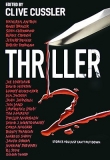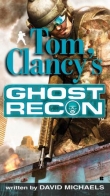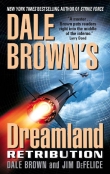
Текст книги "Ghost Fleet: A Novel of the Next World War"
Автор книги: P. Singer
Соавторы: August Cole
Жанр:
Триллеры
сообщить о нарушении
Текущая страница: 29 (всего у книги 37 страниц)
Highway 99, Oahu, Hawaii Special Administrative Zone
Brigadier General Gaylen Adams tried to focus on the taste in his mouth, the familiar mix of bile, dirt, and blood. He hadn’t tasted anything like that that since Kenya.
“Nearly there, sir, this one piece is a bitch,” said Lieutenant Jacobsen. They were huddled in a culvert just beside the concrete roadway. The young officer was new, pressed into duty after Adams’s executive officer had died in the crash. The saniband liquid he had sprayed on Adams’s wound would set in sixty seconds, creating a hard but porous membrane over the wound site. It also contained a long-acting local anesthetic. But the lieutenant needed to work quickly to debride the wound before the spray set or the wound would seal around the dirt.
Adams kept silent, both cursing himself for wanting to be the first Marine to land and counting himself lucky for surviving the fall that had made that wish come true.
Using a pair of tweezers from his med kit, Jacobsen worked out one last piece that had been lodged just under the general’s lip.
“Got it,” said the aide, proudly holding up in his tweezers a sliver of a wooden golf tee the size of a matchstick. Adams could only think that it made the young officer look even younger, like one of his sons playing the board game Operation.
Fortunately, the numbness from the anesthetic had set in by this point. As the general rubbed his jaw, testing the edge of it, a helmetless Marine jumped off the roadway and into the culvert.
“Sir, Colonel Fora sent me back to let you know that we’ve got enemy armor coming,” said the Marine, trying to catch his breath. Adams couldn’t read his name, a scarlet slash of blood painted across the body armor, just his insignia. A corporal.
“How fah ut, Cupril?” Adams asked, his speech slurred by the anesthetic. He looked over in anger at Jacobsen.
“How far out are they, Corporal?” the general’s aide translated.
“Scouts tracking them about a klick away from our position, headed out from the old Schofield Barracks,” said the corporal, unfazed. It was the first time he’d ever talked to a general up close; for all he knew, they always had their aides translate for them. He handed the general a muddy map he’d been given to deliver; the units had been ordered to stay off networks as much as they could.
“Knew ur luck run ut ventually,” Adams said, mostly to himself. Except for his falling out of the back of an Osprey and onto a golf course, the operation had gone about as well as could be expected. Stealing a play from the Russians, they’d launched from the fleet almost four hundred miles out, the maximum range they could fly without refueling.
They had cut it close, all but one of the tiltrotor aircraft making it in on fumes. The strikes from the Z and the Poles had given them a lane through the air defenses, and even better than expected, the initial reaction from the ground defenses had been fierce but localized. It was as if the various Directorate units were operating without any leadership from the top. Adams didn’t know if it was due to the jamming or a lucky hit from the shore bombardment that had killed a Directorate general. He didn’t care; he would take a confused enemy every time.
The downside of their long-range method of infiltration was that his units were fighting lighter than normal. While each of the Ospreys that had landed at locations all up and down the North Shore could carry twenty-four combat-loaded Marines, they couldn’t carry the unit’s complement of artillery or vehicles. The Marines had commandeered civilian vehicles to stay mobile, but they would have to wait for the landing craft to bring them their own armored firepower.
“Colonel Fora said to tell you that he can bring them under fire to delay,” said the scout, “but he is requesting to blow the two bridges just north of town, sir.”
Adams studied the cracked screen of his tablet computer, matching the map to the locations he knew by heart. They could blow the bridges over the Anahulu River, but that would leave his forces on the wrong side of the little harbor in Haleiwa. And he wanted that harbor. As dinky as it was, hosting mostly deep-sea fishing charters before the war, Haleiwa had the only pier on the entire northern side of the island. His Marines could cross the beach, but that little harbor would make offloading the vehicles of the Eleventh Cavalry far easier. And, more important, he didn’t want to lose momentum. Never give an enemy the opportunity to catch his breath; instead, grind your boot down hard on his neck.
He pointed on the map to the juncture of Highways 83 and 99 and the section just beyond Haleiwa, where the main road was raised on concrete pillars above the marshy land and small streams.
“Tell da Z to hut huh and huh.”
He looked over at the young marine corporal, who was waiting to be dismissed.
“Num, son?” said General Adams.
“Name, Corporal?” the aide asked.
“Snyder, sir,” said the corporal.
“Gut joh, Sny-drr,” Adams said slowly, trying to enunciate each word. He nodded at the aide to get to work.
Jacobsen pointed a baseball-bat-size antenna out to sea and set up a directed microwave-burst transmission to the task force; the signal’s frequency hopped with each transmission, allowing it to slip through the Directorate jamming.
“Longboard, Longboard, this is Ares, requesting fire at fo-wer, Quebec, delta, kilo, zero, tree, niner, ait, tree, tree, zero, six, two, niner, and at fo-wer, Quebec, delta, kilo, zero, fo-wer, wun, two, fo-wer, tree, zero, two, niner, zero. Confirm, Longboard,” said the aide, using the military’s phonetic pronunciation for the grid coordinates to ensure distinct sounds.
“Ares, this is Longboard Actual. Copy all, but what’s the situation? Where is Ares Actual? Over.” Adams recognized the voice as Admiral Murray’s.
“Longboard Actual, I’ve got Ares Actual right beside me, but he is, um, verbally incapacitated. I’ll be speaking for him, wait,” Jacobsen said.
“Tull er dat —”
Before Adams could finish the young officer started. “Longboard Actual, present status strong but precarious. Enemy armor column advancing down Route Ninety-Nine. We’ll need fire support to block threat. But not just yet. It’ll cost us, but we want to wait for max effect… I will relay fire order to time for exactly when their column crosses Helemano Stream.”
Adams eyed the young lieutenant with newfound respect. He was crap at surgery, but he was a bloody-minded killer, just the way they’d taught at Quantico.
Highway 99, Oahu, Hawaii Special Administrative Zone
“Snyder, are you sure this is what the general said to do?”
Lance Corporal Ramona Vetter fired off another ten-round burst from her M240 machine gun. The bullets bounced off the lead tank, a Type 99 whose brown-and-green camouflage paint stood out on the highway’s black asphalt. It was belching smoke from where its engine used to be after a direct hit from a Javelin shoulder-fired rocket. Their machine-gun fire wouldn’t cause any damage, but it would keep the crew from exiting.
“Well, not exactly this,” said Snyder, pointing his M4 rifle at the next tank in line, which was pushing the damaged tank off the road. Through his tactical glasses, he could see the Directorate tank designated with a bright green halo. With the road cleared, the tank began to advance toward them again. Another Javelin missile was fired off, but it was deflected by the tank’s active protection defenses, which shot down the incoming missile with a small rocket that detonated the threat fifty meters away.
When the tank finally reached the small stream, Snyder did just what the lieutenant had instructed him to do. Normally, he knew to ignore what lieutenants said, but the general beside him had nodded his approval.
He toggled the glasses menu with a controller mounted on the forward rail of his M4. The connection relayed back to the young lieutenant’s transmission out to sea, and after a few seconds, the system began to push data to Snyder’s glasses, detailing the incoming fire’s expected blast radius.
“Damn. You should see this, Vetter,” said Snyder. He panned his head left and then right. Hundreds of meters out from the projected impact point on the tank, his glasses showed all red, with a warning signal overlaid in bold: Danger Close.
“Whatever they’re firing, it isn’t in the system. Figured it would be a five-incher, but it’s something else.”
“Bigger than a five-incher? You promise?” said Vetter.
“You know, your dirty mouth is going to ruin our Hawaiian honeymoon,” said Snyder. He yelled to the rest of their platoon strung out along the road: “Incoming fire, danger close. Get your asses down!”
“Probably just can’t shoot straight. Typical Navy,” said Vetter. The two of them lay prone in a muddy ditch.
“Yeah, well, you know who the colonel is going to blame when this kills us all? Me,” said Snyder.
He’d barely finished speaking when the roadway before them vaporized in a bloom of orange and white flame. The blast wave lifted Snyder and Vetter a few inches off the ground and then dropped them back into the ditch. Their ears ringing so loud they couldn’t hear anything, they edged back up to the lip. The roadway was now a massive crater where the two lead tanks had been. Even tanks farther away in the column had been flipped onto their backs like turtles.
A second wave of rail-gun fire came in, lifting Snyder and Vetter up again. The effect on the roadway was like scattering hot coals with a sledgehammer. A few seconds later, another two rounds landed in the traffic circle just to the west; now both roads into town were blocked.
Vetter was saying something, but Snyder couldn’t hear her over the ringing in his ears. He scanned across the scene of destruction with his eyewear, tagging each smoldering crater and piece of smoking wreckage with a red circle. The message to the Zumwalt’s ATHENA system was simple: Targets destroyed.
USS Zumwalt Ship Mission Center
The battle had settled into a rhythm, a steady monotone patter of queries and replies as the ship and its crew carried out fire-support missions onshore. The only physical indicator that they were at war was the sound of the room’s cooling fans, which seemed to be working extra-hard.
The holograph map now showed the Z joined by the rest of the task force, an arc of escort ships surrounding a convoy of transport vessels, all moving closer to shore. A blue bubble overhead extending almost a hundred and ten miles out indicated the air-defense range provided by the USS Port Royal, the Aegis cruiser accompanying the task force. Beyond it, small moving icons indicated the Mako ships sweeping for underwater threats and a small combat air patrol of six F-35Bs overhead. They were from the USS America, the amphibious assault ship at the center of the task force. The America also served as Admiral Murray’s flagship and so was marked by a bolder icon.
The America lacked an aircraft catapult launch and arrestment recovery equipment, which meant it could carry only those aircraft that could take off and land vertically, like F-35Bs, helicopters, and Ospreys. But for all other purposes, it was essentially a forty-five-thousand-ton aircraft carrier that could also load twenty-five hundred Marines, and, most important, it ran on non-nuclear engines. The mission planners had swapped out its normal heavy helicopter complement for the bulk of the first Osprey wave, which were joined by other Ospreys that had flown off the accompanying San Antonio– and Austin-class landing ships brought out of retirement in the Ghost Fleet. The arrival of so many of the big, slow, non-stealthy ships meant Task Force Longboard’s presence would now be much more evident to any Directorate sensors, but being surrounded by other ships felt comforting to all in the Z.
“Captain, we have an incoming drone from the north,” a sailor announced. “Its squawking code says point of origin is Shemya?”
Cortez started to read off his glasses. “Shemya… Aleutian Islands. There’s an old Air Force weather station there that has an emergency-landing airfield. Not so great for that; says the wind never drops below sixty miles per hour and there’s a ten-foot visibility fog three hundred days of the year. That explains it; robots don’t mind the weather. Op plan has it used as a relay station for secure drone comms. A Pony Express – style handover.”
“Allow download. It is about time we finally get some news on what’s happening up north,” said the captain.
Within a minute, Cortez appeared at Simmons’s side with a tablet screen. It showed an animated map of the current and projected locations of the U.S. forces making their way through the Arctic passage. Noticeably absent was the Directorate battle fleet that was supposed to have been drawn north.
“Shit,” said Simmons.
Cortez nodded, and he winced slightly as he read the message aloud.
“ ‘No contact Directorate battle fleet. Undetected from searches in Bering and off Aleutians. In absence of further information, must assume strong substantial attack force proceeding towards your area of operations. In carrying out the task assigned in operation plan twenty-nine – forty-two, you will be governed by the principle of calculated risk, which you shall interpret to mean the avoidance of exposure of your force to attack by superior enemy forces without good prospect of inflicting greater damage to the enemy. Given communications link delays and uncertainty, decision authority is now with task force commander. COMPACOM will support. But priority is to protect the fleet in being.’ ”
“Sir, we have Admiral Murray on the localized net for you,” Cortez said. The video link opened, and the admiral appeared.
“You’ve seen the message?” she asked.
“Yes, ma’am.”
“Then you know what it means?” she asked.
“Yes. PACOM is not going to say it, but they’re giving us the option to withdraw if the situation turns too hairy,” he responded. “Which would hang the Marines onshore out to dry.”
“That is indeed what it means, Captain,” she said. “That’s the tradeoff. Instead of being puppeted from afar like in the last war, we get the kind of command freedom our predecessors dreamed of. But it also means the hard calls get piled on our shoulders.”
Simmons’s eyes flashed up to the monitor bank showing the array of system updates and videos of Marine combat footage. How many hours had it been since he’d seen the sea? It should have been easy to follow a cold-hearted, calculated order like this because he was devoid of any physical contact with the war and was essentially playing a video game in this floating box. It wasn’t.
“We will proceed as planned,” said Murray. “But be aware of the option if needed. I’ll give General Adams the bad news myself.”
No more than ten minutes after she had signed off, another urgent transmission came in.
“It’s the bird on the northwest patrol,” Cortez said, pointing to the icon on the holographic tactical display.
“Let’s hear it,” said Simmons.
“Big Bird, Double Down Four,” said the female pilot. “You have an incoming flight of sixty-plus enemy jets. I repeat, six-zero-plus enemy jets, coming from the northwest. They’ve got carriers out there somewhere. Double Down Four is engaging, but…” The pilot trailed off.
They all knew. It was best left unsaid. Her F-35B was one of the handful of jump jets squeezed onto the USS America to form the task force’s combat air patrol. Given what had happened to their predecessors, all the pilots had been volunteers. Their planes had been scanned and rescanned and as many of the suspect chips swapped out as possible, replaced with chips scavenged from donated commercial gear. But there was no certainty they’d removed all of the Trojan horse hardware. The technicians likened it to trying to find a particular needle in a haystack made of needles. But finding bad chips was actually even harder than that, as they activated only in the presence of a combination of an unknown frequency and an encrypted transmittal message.
Her voice sounded strained as she braced against the increasing g-load that went with her aggressive tactical turn toward the threat in the northwest. The flight suit fought the physics of the maneuver but it was always a losing battle. “We’ll do what we can, but expect incoming within fifteen minutes. Double Down Four out.”
Double Down 4 stopped transmitting and fired a salvo of joint dual-role air dominance missiles at the squadron of Chinese Shenyang J-31 fighters that had entered the defense sector. The Chinese planes were almost her jet’s twins, having benefited during their development from F-35 blueprints stolen by hackers in 2009. Her incoming-missile warning alerted her that the closest one had counterfired a PL-21D. Powered by ramjets, it closed quickly, so she banked hard and up to get some altitude. Then she activated the broadcast protocol. To counter the risk of some traitor chip signaling out, the whiz kids had dreamed up the idea of flooding all the frequencies. All stealth was lost, but the theory was that whatever homing beacon the missiles were trying to ride in on would be overwhelmed by all the other signals broadcasting.
She rotated the plane so she was inverted, catching a glimpse of the incoming missile exhaust streaking toward her as she did. The F-35 automatically fired off a dozen flares, and she put the plane straight down into a dive that made it crack the sound barrier. The missile kept climbing past her, seemingly fooled for the moment. Double Down 4 turned again, visually hunting for another target, her search radar rendered useless by the mix of the enemy’s and her own jamming. In the distance, she saw an explosion. At least one of her missiles had made contact.
All of this was invisible to the Zumwalt’s crew, still haunted by the clipped tone of her transmission. Jamming made it impossible for them to hear anything more. This spared the crew from hearing Double Down 4’s choked scream as 30 mm cannon fire from a Russian Su-33 gutted her plane’s belly. The only indication of her fate came when the all-frequency jamming stopped and ATHENA changed the F-35 icon from blue to gray and then moved it off the screen.
“Ladies and gentlemen, it seems we have found the rest of the enemy fleet,” said Simmons. “You know what to do.”
Wolf Flight, Pacific Ocean
Some 120 miles away from the Zumwalt, Captain Second Rank Alexei Denisov swept the sky again, craning his neck to look past his MiG-35’s twin tails. He wanted to confirm what his cockpit displays and flight communications told him: the last of the American combat air patrol had been shot down. He looked around his plane; all that remained was a faint haze of smoke from the dogfight.
This was a perfect coda, he believed. He had been there at the beginning and would be there at the end of it all. How many decades had the Americans claimed the world’s skies? No more.
“White and Red Squadrons, this is Dagger-Three-Thirty-Four. Sky looks clear of any enemy planes.” He checked his radar screen again; still no targets acquired. Both sides were jamming each other, and neither could cut through the electronic fog until they closed.
“Begin your attack, Formation Wolf Hunt,” said Denisov.
Denisov pulled back on the stick and slowed, allowing the aircraft to reposition itself into the attack formation. Within seconds, the Russian MiG-35s and Su-33s of White Squadron and the Chinese J-31s of Red Squadron were neatly arrayed in a line extending two hundred kilometers, just as they had trained on the simulators for weeks. Like wolves on the Siberian plains, they would sweep forward until some part of the line made contact, then all the others would close in in a circle. It was simple but brutally effective.
USS Zumwalt Ship Mission Center
“Damn it to hell,” said an angry voice, not bothering to keep her frustration in check. The sailor was just out of Simmons’s line of sight, but her frustration was clear.
He walked down the stairs to the sailor’s workstation. “Patience, Richter, just have patience,” said Simmons in a calming voice.
“Aye, sir,” said Operations Specialist Angelique Richter, a bit surprised to find the captain leaning over her shoulder to look at the three screens at the workstation she was using. A diminutive twenty-five-year-old radar systems operator, she wore a matte-black eyebrow stud like the ones many of the female Marines wore. “Might as well turn the damn thing off, sir, jamming’s only getting worse.”
“Ebb and flow, Richter, that’s how this is going to go,” said Simmons. “You get a glimpse, then you use what little you have. Don’t forget: they’re just as confused as we are.”
The girl nodded, running chewed fingernails over her shaved head.
“Richter, you’ve been in three years now, right?” said Simmons.
“It will be four years in two months, sir,” she said.
“That’s a lot of Navy in your blood,” said Simmons. “Makes you one of the sailors I’m counting on today. There’s nothing here you can’t handle. What we know is all we know. Got me?”
“Aye, sir.”
He was walking back up the stairs to the observation floor when the radar operator called him.
“Sir, we’ve bogeys coming in from the northwest. They’re strung out in a long line,” Richter said. Then, in a lower pitch: “ATHENA counts sixty-two in total.
“Shit,” the radar operator continued. “It’s worse than that. ATHENA is now showing something coming in from the east. It’s patchy, but at least a hundred bogeys… we’re right square in the middle.”
As the information from her screen began to populate the central tactical hologram where all could see it, the room seemed to grow more quiet. A brief groan from the ship’s engines welled up through the hull, as if the Zumwalt had just accepted its fate.
Then a voice rang out over the speakers arrayed around the room. It had a gravelly, Southern twang: “Longboard, this is Boneyard Six Four. You seem to have some party crashers on the way. Can we be of assistance? Over.”

![Книга [Magazine 1966-07] - The Ghost Riders Affair автора Harry Whittington](http://itexts.net/files/books/110/oblozhka-knigi-magazine-1966-07-the-ghost-riders-affair-199012.jpg)






